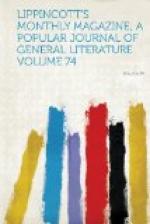ILLUSTRATIONS
The great annual fair at NIZHNEE-Novgorod.
Crystal palace—London exhibition building, 1851.
Interior view of the transept of crystal palace.
New York exhibition building, 1853.
Cork exhibition building, 1853.
Dublin exhibition building, 1853.
Munich exhibition building, 1854.
Manchester exhibition building, 1857.
Florence exhibition building, 1861
Paris exposition building and grounds, 1867.
Grand vestibule of the Paris exposition building, 1867.
Vienna exposition building and grounds, 1873.
Rotunda of the Vienna exposition building, 1873.
Mussulman woman of bhopal.
A nautch-girl (or bayadere) of Ulwur.
A NAUTCHNI (or bayadere) of Baroda.
The cathacks (or dancing men) of bhopal.
Burial place of the rajahs of jhansi.
Tomb of Allum Sayed.
Peasants of the Douab.
Hindu bankers of Delhi.
The grand hall of the Dewani Khas in the palace of Delhi.
The Jammah masjid at Delhi.
LIPPINCOTT’S MAGAZINE
OF
POPULAR LITERATURE AND SCIENCE.
MARCH, 1876.
Vol. XVII, No. 99.
THE CENTURY—ITS FRUITS AND ITS FESTIVAL.
III.—PAST EXPOSITIONS.
[Illustration: The great annual fair at NIZHNEE-Novgorod.]
We have presented a feeble sketch of a century that stands out from its fellows, not as a mere continuation, or even intensification, of them—a hundred annual circuits of the earth in its orbit as little distinguished by intellectual or material achievement as those repetitions of the old beaten track through space are by astronomical incident—but as an epoch sui generis, a century d’elite, picked out from the long ranks of time for special service, charged by Fate with an extraordinary duty, and decorated for its successful performance. Those of its historic comrades even partially so honored are few indeed. They will not make a platoon—scarce a corporal’s guard. We should seek them, for instance, in the Periclean age, when eternal beauty, and something very like eternal truth, gained a habitation upon earth through the chisel and the pen; in the first years of the Roman empire, when the whole temperate zone west of China found itself politically and socially a unit, at rest but for the labors of peace; and in the sixteenth century, when the area fit for the support of man was suddenly doubled, when the nominal value of his possessions was additionally doubled by the mines of Mexico and Peru, and when his mental implements were in a far greater proportion multiplied by the press.




